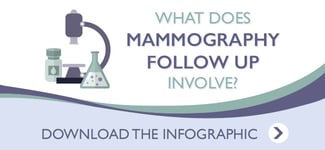 Noticing a lump or getting a call back after your mammogram can be scary. It’s fairly common knowledge that 1 in 8 women develop breast cancer within their lifetimes.[1] However, only a small percentage of women who are called back after a mammogram are found to have breast cancer.[2] The fact is that there are a number of benign conditions that can create lumps or other features that can appear similar to cancer on mammography images. While some are associated with an increased risk of developing cancer in the future, others pose no risk to a woman’s health.
Noticing a lump or getting a call back after your mammogram can be scary. It’s fairly common knowledge that 1 in 8 women develop breast cancer within their lifetimes.[1] However, only a small percentage of women who are called back after a mammogram are found to have breast cancer.[2] The fact is that there are a number of benign conditions that can create lumps or other features that can appear similar to cancer on mammography images. While some are associated with an increased risk of developing cancer in the future, others pose no risk to a woman’s health.
Cysts
Cysts are round, fluid-filled masses that often develop in the breast. They can cause pain, swelling, and tenderness that can fluctuate throughout the menstrual cycle. Often, cysts do not require treatment, but they can be aspirated (drained) if they cause significant discomfort. Cysts that are completely fluid filled are called simple cysts and do not require follow up. Doctors sometimes recommend biopsy for complex cysts—those that also contain some solid material. However, these rarely turn out to be cancerous.[3]
Calcifications
Calcifications are simply small mineral deposits that commonly occur in the breast. Alone, they pose no risk to a woman’s health. However, when calcifications appear in certain patters, they can indicate the development of breast cancer. Depending on the size and appearance of calcifications, a radiologist may recommend biopsy, more frequent breast cancer screening, or no action at all.[4]
Fibroadenomas
Fibroadenoma is the most common type of benign breast mass, occurring most commonly in women aged 15–35.[5] If felt through the skin, they tend to feel rubbery, firm, and moveable. They don’t increase a woman’s risk of developing breast cancer and often don’t need treatment. If fibroadenomas become large or very uncomfortable, then they can be removed.[6]
Debate exists as to whether fibroadenomas increase a woman’s risk of developing breast cancer or have little or no effect on breast cancer risk. If you develop one or more fibroadenomas, talk to your doctor (or preferably, more than one doctor) about what follow up is appropriate for your condition.
Fibrosis
Fibrosis simply means thickening of the breast tissue. The breast tissue may feel rubbery or firm to the touch. This is a benign process often caused by hormonal fluctuations, which can cause the size of lumps to vary throughout the menstrual cycle. Fibrosis has no effect on breast cancer risk.[7]
Adenosis
Adenosis involves enlargement of the breast lobules and is often found in women with fibrocystic breast changes (fibrosis and/or cysts). Sclerosing adenosis is a condition in which small lumps form in the breast lobule. They have a distorted shape and may contain calcifications, which can make them appear on a mammogram to be breast cancer. These conditions themselves do not require treatment, but biopsy may be needed to rule out breast cancer.[8]
Radial Scars
Radial scarring (sometimes called complex sclerosing lesions) is another condition that can look like cancer on a mammogram but is in itself benign. Many providers nonetheless recommend removal of radial scars because they sometimes include cancer cells.[9] Studies provide conflicting evidence as to whether these features increase breast cancer risk.[10]
Hyperplasia
Hyperplasia simply means an overgrowth of cells, usually occurring in breast lobules or milk ducts. Hyperplasia is classified as usual if the cells look normal under a microscope and atypical if cells appear abnormal.[11] Hyperplasia does not usually require treatment; however, women with atypical hyperplasia are often advised to undergo additional breast cancer screening.[12]
Intraductal Papillomas
Intraductal papillomas are small, benign wart-like tumors that appear in the milk ducts. They contain a combination of fibrous tissue and blood vessels and can cause pain and clear or bloody nipple discharge. Typical treatment is surgical removal. It is believed that a single intraductal papilloma has no effect on breast cancer risk but multiple papillomas are associated with a slight increase in risk.[13]
At Iowa Radiology, we know that getting a call back to schedule follow up after your mammogram can be distressing. We believe in taking a more compassionate, patient-centered approach to medicine and take steps to ensure our patients are as comfortable as possible during their time with us and fully informed about the procedures they’re undergoing. Feel free to reach out to us with any questions you have about procedures performed at our clinics. For more information about mammography follow up, access our free resources using the links below.
[1] "U.S. Breast Cancer Statistics." Breastcancer.org, 13 Feb 2019. Accessed 20 Jun 2019.
[2] "If You're Called Back After a Mammogram." Cancer.org. American Cancer Society, 8 Oct 2018. Accessed 20 Jun 2019.
[3] Daly, Bailey, et al. "Complicated Breast Cysts on Sonography." Academic Radiology, vol. 15, no. 5, 2008, pp. 610–617.
[4] "Breast Calcifications. WebMD, 23 Nov 2017. Accessed 20 Jun 2019.
[5] "Fibroadenoma." MayoClinic.org. Mayo Foundation for Medical Education and Research, 6 Mar 2018. Accessed 20 Jun 2019.
[6] "Benign Breast Conditions." Susan G Komen, 5 March 2018. Accessed 20 Jun 2019.
[7] "Fibrosis and Simple Cysts in the Breast." Cancer.org. American Cancer Society, 20 Sept 2017. Accessed 20 Jun 2019.
[8] "Adenosis of the Breast." Cancer.org. American Cancer Society, 20 Sept 2017. Accessed 20 Jun 2017
[9] "Radial Scars." Breastcancer.org, 16 Oct 2018. Accessed 20 Jun2019.
[10] "Breast Calcifications." WebMD, 23 Nov 2017. Accessed 20 Jun 2019.
[11] "Hyperplasia of the Breast (Ductal or Lobular)." Cancer.org. American Cancer Society, 20 Sept 2017. Accessed 20 Jun 2019.
[12] "Benign Breast Conditions." Susan G Komen, 5 March 2018. Accessed 20 Jun 2019.
[13] "Intraductal Papillomas of the Breast." Cancer.org. American Cancer Society, 20 Sept 2017. Accessed 20 Jun 2019.



